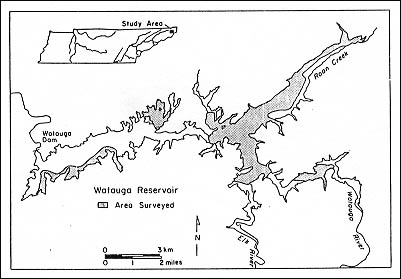by C. Clifford Boyd, Jr., Radford University, Radford, Virginia

Watauga Reservoir Survey Area
From September 1983 until the end of February 1984, graduate students from the University of Tennessee, Knoxville, conducted an archaeological survey of the Watauga Reservoir in Carter and Johnson Counties in upper East Tennessee (Figure). The survey was supervised by the author, under the direction of Jefferson Chapman of the McClung Museum. The archaeologists worked out of the museum, and all artifact collections were washed and analyzed using the museum laboratory facilities. All the artifacts and records of this survey are also currently curated at the McClung Museum.
This survey was conducted at the request of the Tennessee Valley Authority, to comply with federal legislation requiring the TVA to survey all lands they control for the presence of archaeological sites. The Watauga Reservoir had been completed in 1948, but no pre-inundation site survey had been conducted. However, with a major lake drawdown in 1983 for dam repair, the opportunity presented itself for such a survey in the exposed areas of the reservoir.
Surveying a drained reservoir was certainly an educational experience for everyone involved. Areas on the floor of the reservoir were covered with silt, which measured from a few inches to two feet thick. The silt had been deposited on the original ground surface after inundation. Identifying sites in these areas where much of the ground surface was obscured required examining stream banks, road cuts, or other areas where the silt had eroded away. Areas of the reservoir with steeper slopes showed severe erosion and deflation, resulting in the significant movement of soils, rocks, and artifacts downslope. These reservoir-induced natural transformations of the survey area made the identification of sites difficult.
Also, because the drawdown occurred during the winter, fieldworkers had to contend with the often harsh winter conditions in the mountains of upper East Tennessee. The weather in this area could (and did) change from sunny and spring-like to snowy and freezing in a matter of minutes. Wading through mud, fording streams on foot, avoiding uncovered cisterns and wells, and contending with armed artifact collectors made the fieldwork exciting, to say the least.
In spite of these challenges, 111 previously unrecorded prehistoric sites were identified and documented. Surface collections of artifacts were obtained for all of these sites. In addition, 10 sites were tested to identify intact subsurface artifact-bearing deposits or features. Thirteen prehistoric aboriginal features were identified at four sites and three of these contained sufficient charcoal for radiocarbon dating. Two features, which dated to the seventh century AD, produced Hamilton-like projectile points and limestone or grit tempered ceramics with mainly netimpressed, cordmarked, or smoothed surface treatments. The third feature, dated to the sixteenth century AD, contained soapstone tempered ceramics with decorations similar to the Burke series ceramics from the eastern Blue Ridge in North Carolina.
By far, the most prevalent components represented in the Watauga Reservoir were the Late Archaic (3000-1000 BC) and Late Woodland/Late Prehistoric (AD 700-1500) components. Many of the latter sites produced a variety of ceramic artifacts whose surface treatments and decorations reflected cultural connections among the Mississippian Dallas and Pisgah cultures of East Tennessee and western North Carolina and the Late Woodland cultures of southwest Virginia.
The Watauga Reservoir, and upper East Tennessee in general, may represent an important “crossroads” in which disparate aboriginal cultures from what is now East Tennessee, North Carolina, and Virginia interacted. Future research in this area should address this important question of prehistoric culture contact and exchange.
The results of this work have been published as Archaeological Investigations in the Watauga Reservoir, Carter and Johnson Counties, Tennessee by C. Clifford Boyd, Jr., Tennessee Valley Authority, Publications in Anthropology, No. 46, and University of Tennessee, Department of Anthropology, Report of Investigations No. 44.